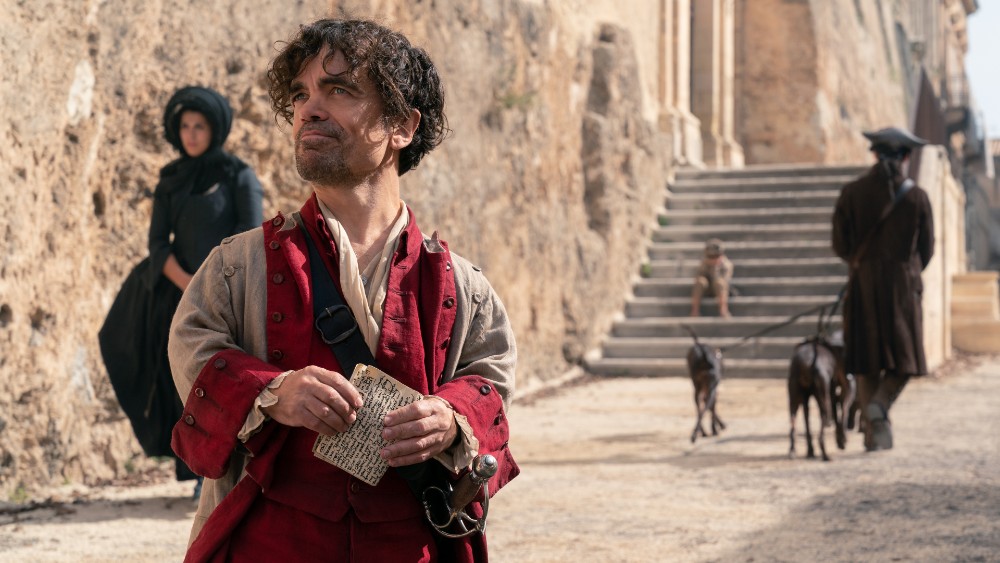
A fixture on stage for more than 100 years, Cyrano de Bergerac returns in Cyrano, a musical romance starring Peter Dinklage as the lovelorn poet and Haley Bennett as his obsession, Roxanne.
Spurred by a case of mistaken identity, Cyrano reluctantly agrees to teach fellow soldier Christian (Kelvin Harrison Jr.) how to woo Roxanne, who is also being pursued by the lecherous Duke De Guiche (Ben Mendelsohn).
As envisioned by director Joe Wright and screenwriter Erica Schmidt, Cyrano showcases a dazzling, idealized version of 17th Century France. Packed theaters alternate with elaborately furnished suites, soldiers are housed in seaside fortresses, aristocrats glide above the starving poor, and dark alleys teem with cutthroats.
Crucial to the look of Cyrano is the work of Seamus McGarvey, an Oscar-nominated cinematographer who previously collaborated with Wright on Atonement and Anna Karenina. McGarvey spoke with Below the Line at this year’s EnergaCAMERIMAGE in Toruń, Poland.
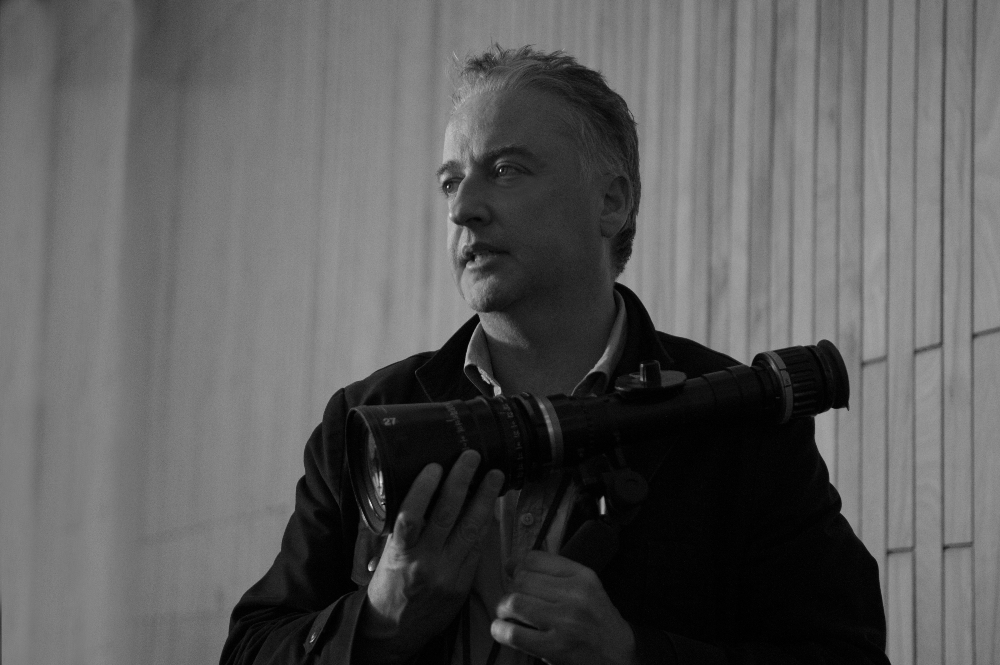
Below the Line: How has your experience here at Camerimage been?
Seamus McGarvey: It’s so lovely to come to Camerimage, the audience is just amazing, first of all, because you know everyone’s a filmmaker or writer or cinematographer. But there’s also a passion, which means that the questions that are asked or discussions that you have are imbued with thought about cinema itself. When you have conversations like that, it prompts you to think about your own work in a way that sort of expands it.
That’s the lovely thing about being here, having those convivial, sometimes a bit tinctured conversations that allow you to explore the idea in your own work that ‘one plus one equals three.’
BTL: How did you approach bringing this musical from the stage to the screen?
McGarvey: I’ve worked on song-and-dance type films, like The Greatest Showman, which was really enjoyable to shoot, but a completely different beast. In Cyrano, the song lyrics are as important as the dialogue that precedes or follows each number. That allowed us to really think about the mechanics of filmmaking. How do we come in and out of the music without it feeling like the juggernaut of narrative has stopped dead?
The music has a gentle quality that allows the actor to go from regular dialogue into singing in a way that isn’t disruptive to the flow. Technically speaking, that was our guide. The sound was recorded live, so you feel every accident, every break, every quiver of the voice, and the emotion of the actor in their character. It’s not playback recorded three months in advance, it’s the actual performance. You really feel that on the screen.
BTL: Can you talk more about developing a visual approach to the musical numbers?
McGarvey: We talked about portraiture, and about people being separated in rooms, but yearning for each other. The idea of montage through portraiture was key. That made us think, well, we’re never going to do a “song-and-dance” number, although we did once. Still, it’s not going to be proscenium style. We want it to feel like their voices in their heads are full of yearning. You do that through portraiture.
Our large-format camera and our lovely Leitz lenses reminded me of my days running around with a Rolleiflex or Hasselblad, photographing my friends and revealing the results in the darkroom, saying, ‘Oh my God, look at her eyes,’ or ‘Look at the wrinkles in his face.’ All those things that are depicted in a large format. That was our guide. We knew we were going to be extremely close and extremely wide, [with] very little mid-ground in between.
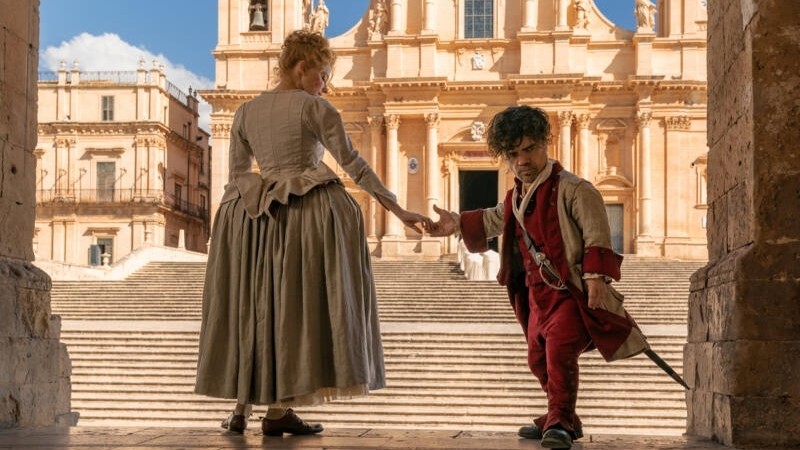
BTL: How do you express longing and yearning in a close-up? Take the scene in a bakery when Roxanne dresses Cyrano’s wound. It’s so highly charged…
McGarvey: Joe is very fond of hands, it’s one of his signatures. I love them too, the photographs of hands by Stieglitz, Steichen. Georgia O’Keefe’s hands, one of my favorite images.
The script was written with that in mind. Originally, it was a different injury, but the hands are so expressive. One of my favorite shots in Atonement is when his hand touches the water. In Anna Karenina, there’s that closeup of the cigarette in the hand.
It’s about simplifying things. Going fishing and not disturbing the fish. When an actor starts off, it’s all ripply. Things happen when an actor tries something and then tries something else without disturbance. Eventually, they’ll find it. It’s about saying, ‘I’m not doing a fancy tracking shot,’ which I’ve done loads of times with Joe. It’s about sitting back and waiting.
The closeups in that scene, we were back in the shadows on a 100 mm lens. The actor doesn’t feel you there. Also, we didn’t shoot much frontal closeups, we were off to the side, off the eyeline. That has two effects. One, you can leave part of the face in shadow, which is beautiful for portraiture. You get a soft light on part of the face, yet you still see the light in the eyes. You see the iris, the moisture appearing on that angle when part of the face is in shadow. It’s just about sitting back and waiting for the moment to come from the performer.
A lot of the lighting comes from the actual locations. When we scouted the palazzo that became Roxanne’s room, there was the most exquisite afternoon sunlight crashing onto the wall. The whole room was lit in underexposed bounce light, with a wall overexposed seven stops behind. That’s what we tried to emulate.
When we were scouting it at night, the owner had lit it with candles. You think, ‘That’s how we’re going to do it.’ At least give the impression of candlelight, because it has a lovely fall off and is very soft on actors’ faces. You can play with the light’s movement, the almost imperceptible oscillation with candlelight that adds a psychological instability to the moment.
BTL: Were you using filters with the candlelight?
McGarvey: I’m an old tart when it comes to filter effects. One [that] I love for some but not all of its attributes is my Christian Dior 10 denier stockings. It’s an old Hollywood effect. You always get asked back by the actress for the next film because it makes her glow like an opalescent goddess. You basically stick them on the back of the lens and stretch them.
I don’t like when photography draws its attention to itself, either in filtration or movement or lensing or effects. Sometimes I pulled those stockings off. When Roxanne and the Duke are in that room with the bright windows, the voile on them was blooming too much, wrapping around the figures. So I would change to a Tiffen Black Glimmerglass filter, which had a less pronounced effect but which we needed for continuity.
BTL: There’s also a shot with pronounced atmosphere when Roxanne is walking down a street…
McGarvey: That shot — they call it “magic hour,” but I call it the “screaming hour.” Thank God for digital sensors. It was virtually dark when we shot that, the sun had gone down. Everyone’s screaming at each other, it’s so high-octane, and Hailey’s got to sing a song and keep her composure while everyone’s going nuts. When we finally got to the end of that shot, it was night.
You have to be there athletic enough (which I’m not, I mean, creatively athletic) to be able to not lose your mind when the sun’s about to go. Up in the mountain, that shot where he sprints and we were tracking at speed on a platform, it was virtually night. I had to open the shutter of the camera, and you can see his feet are a complete blur. In fact, it looks like he has no feet, that he’s just hovering like a cartoon.
BTL: You say you’re trying for simplicity, and then you have an incredible shot that takes viewers into a crowded theater.
McGarvey: That’s a classic Joe shot, a combination of Steadicam, choreography, mise en scène, dialogue off-and-on-camera. The play of light establishing the hubbub, going from the interior mind in a closeup to gradually widening, widening, widening; the crowding of the frame, the sort of zoetrope effect of people crossing.
The actual act of going through a doorway portal into the theater noise, you hear the cacophony of voices and see [production designer] Sarah Greenwood‘s lights flickering, the chandeliers tinkling. All those cinema effects that subconsciously create in an audience what Joe wants, which is the excitement and the wonder and the awe of attending the theater.
We’re with Christian’s character, and like Joe did in Atonement, he goes from subjectivity to objectivity in the same shot. First you have the sense that you’re in Christian’s head, you can almost hear the “thump, thump” of his heart. Then you’re into the wide shot. I love that we’re playing with the audience’s perception of artifice. We’re taking a velvet glove and slapping the audience in the face.
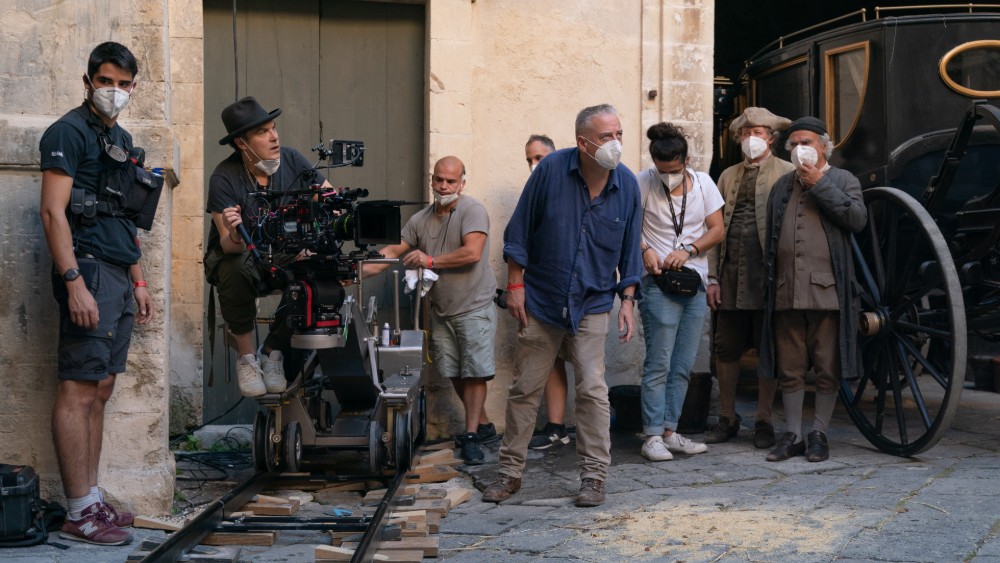
BTL: How long did it take to shoot that?
McGarvey: We started at three o’clock or so when it was still light and rehearsed until it was dark enough to shoot. That first shot, we had a little bit of light in the sky. It was a crepuscular moment where there’s enough ambience at a low level of four stops under to at least register a wide shot. The point sources were all candles, real candles. They kept blowing out or dripping wax on the poor extras underneath. It was a nightmare.
BTL: I’m not sure how you mapped the camera moves. Can you explain?
McGarvey: It’s old school. We just take a finder. Joe has a great sense of movement, so he knew what he wanted, the lines of dialogue he needed to hear. I’ll say, ‘Let’s not look straight out the door when we’re on Christian when we start, let’s be on an angle. Then we can do it in one take.’ Joe’s eyes light up at that notion. We enter in sort of a three-quarter, we just follow through, and then at one point, we’re on Christian’s back. That allows my camera to move counterpoint, like you’re cork-screwing the audience, torquing everyone into it. The choreography takes him further from us, so you don’t have to cut to a wide shot. The artist is doing it for you. The set is doing it for you, which we thought about in advance.
BTL: And can you talk about the theater scene, which ends with a duel?
McGarvey: The duel was very assiduously rehearsed, not only in terms of stunts and swordplay but in [terms of] how the song fits into the action, the rhythm of the blades clashing, [and] how that created percussion.
Joe was guiding it the whole time, but they’d been rehearsing for two weeks before they were even in a position to give us a look at it. Joe and I then worked out the dimensions of the stage where we’re going to shoot. We’ll be at the back of the stage, so we’re going to need a platform because we can’t get wide enough otherwise to get that shot looking back into the audience. We’ll have to pull away, so we’ll also need scenery that can fly. Not only that, I want a 30-foot Technocrane, but we’re building in a car park on a slope. So we will need an engineer to make sure the platform is good for a 10-ton load. We’ll need a crane to lift the Technocrane onto the platform.
All these things crystallized during preproduction meetings. My team is taking notes. Like, we’ll need a balloon, because the lights will be dimming, but I don’t want the audience to go black. I want to see their faces. So I need a balloon that is tungsten. It will feel like a bounce light from the stage, and we’ll be able to see three or four stops underexposed light in the audience’s eyes. We can’t use lights on the floor, so we need a helium light source that I can tug around.
You need to know the type of lights to make your day. That way you’re not saying to the AD, ‘I’m sorry, I need to rig a T 12 up there,’ [because] that would take an hour-and-a-half.
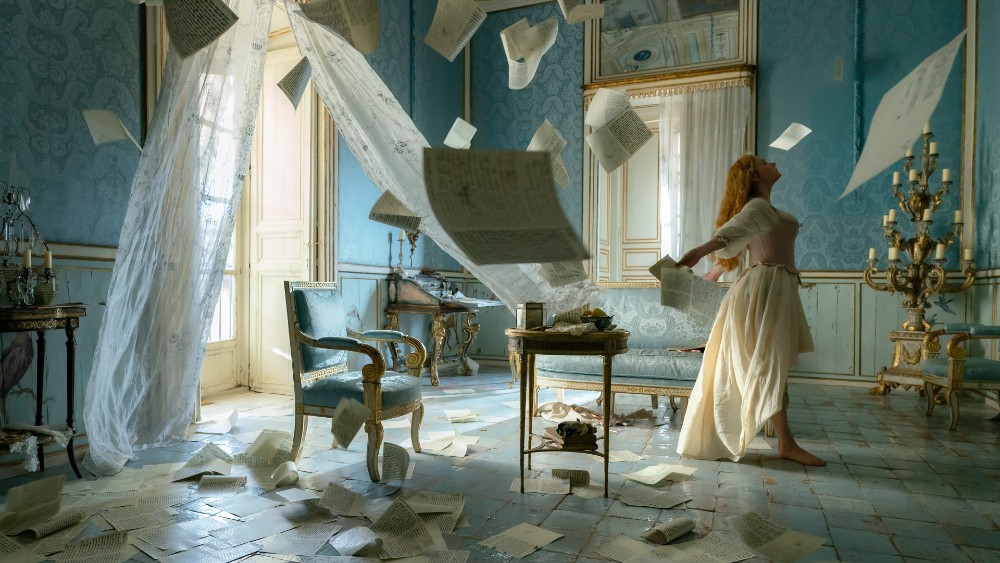
BTL: I liked how the choreography helps determine how close or far you are from the duel.
McGarvey: It’s [the] usual kind of fight club stuff, but I’d never shot a sword fight before. I’m very often guided by the stunt person, who will say something like, ‘That parry will look best from this angle because we can hide the near-miss on the opposite side of the face.’
Joe is really good with this. We have lovely discussions about syntax and the sequence of shots and fashioning a shot as though it’s the French caméra-stylo, the camera pen. I love thinking about the effect of a lens or a movement or light means.
BTL: Can you talk a bit about your crew?
McGarvey: I had a great gaffer, Stefano Marino, who’s worked with the giants like Storraro. I love when you’re working with a gaffer, especially for the first time, and especially in another language, to whom you can speak abstractly. I don’t need to say, as I do sometimes with other people, ‘Okay, we’re going put a T 12 up there, I need some negative fill here.’ Much more specific. With Stefano, you can speak in almost tonal terms. That allows me to think more clearly in artistic terms, but it also allows them to weave themselves more creatively into the work. I’m not dictating anything, I’m not being prescriptive over their contributions.
Joe is a consummate filmmaker because he really knows his shit technically. He demands the best of every single crew member, down to the musicality of a grip who is built like a shithouse door, but who has to dance like a ballerina with the dolly. We had a brilliant key grip, Giorgio Pezzotti. I’ve never seen anybody like him. He is built like a bulldog, but he’s so sensitive and has such a musical air.
We had a really wonderful second unit director/DP, Kate Arizmandi. She’s only in her early thirties. A lot of those closeups of writing, for instance, were done by Kate while we were shooting another sequence. It was lovely to have somebody do that stuff because to get those things right, you have to labor over them like a commercial almost. Those letter closeups are mostly her shots.
BTL: Look at you, Seamus, always deferring credit…
McGarvey: No, but what I do say is that a film crew is a centipede on overtime. You need to both delegate, but also guide, gently guide, because people do things that are completely their own. You can get a kaleidoscopic effect, which is something you don’t need. My job as head of the department of cinematography is to say to the grip, ‘I want you to dance like Pavlova.’ Or say, ‘I want the lighting to look like Titian’s landscapes.’
Cyrano opens in theaters nationwide on Friday, Feb. 25.





